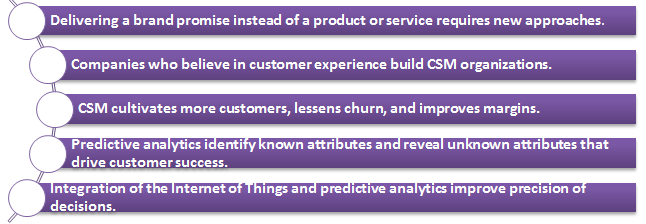Welcome back to Part 2 of my vendor profile of ServiceSource® (part 1 available here). If you’d like to view the table of contents plus a few pages of the report, just scroll to the bottom of this post!
Customer Success Management Field Sees Tremendous Growth
Through conversations with clients, prospective buyers, system integrators, partners, and vendors, Constellation sees five big themes in customer success management (see Figure 1)[1]:
- Delivering a brand promise instead of a product or service requires new approaches. The onus of delivering on the brand promise – providing great experiences with a company no matter when the customer interacts with it – is putting new pressures on brands and software vendors. This means the business model of both must shift. A company’s business model must move post-sales care to a more mature level. This evolution requires a different mindset and approach to customer lifetime value.
Figure 1. Four Areas Needed to Master Customer Success Management
[1] See “The State of Customer Success Management 2015” by Natalie Petouhoff, Constellation Research, December 22, 2014.
- Companies who believe in customer experience build CSM organizations. Not all CSM organizations are created equally. In an opt-in economy, the economic value of a customer is realized over time, instead of in the upfront sale. This means that organizations that want to become CSM-oriented are looking at three main areas:
- Hiring, training and rewards for employees
- Becoming a center of excellence for CSM
- Strategy combined with data
- CSM cultivates more customers, lowers churn, and improves margins. The reason many companies have adopted the opt-in business model is that they realize, when they consistently deliver great experiences, they have loyal customers who advocate for the brand and often will make referrals. Advocating for the brand can be in the form of a post in a social network or offline in telling friends or family of their experiences.
- Predictive analytics identify known attributes and reveal previously unknown attributes that drive customer success. The only way to preserve a company’s revenue stream is to keep customers opting in. To become a CSM organization, a company has to actively manage customer relationships to ensure the customer is getting value. This critical step requires data in the form of real-time and predictive analytics.
- Integration of the Internet of Things and predictive analytics improves precision of decisions. The amount of data and analytics that CSM platforms provide is important, especially when data from sensors and other sources (that make up the Internet of Things) is integrated into the solution to provide a company with predictive analytics and actionable insights that drive better and more precise decision making throughout an organization.
Be sure to check out my vendor profile of ServiceSource®. An excerpt of the profile including the table of contents is available to download.
View part 1 of my vendor profile of ServiceSource.
@drnatalie
VP and Principal Analyst, Constellation Research, Covering Customer Success Management, IOT, Analytics and Customer-facing Applications that Deliver Enhanced, Trust-building Customer Experiences via Customer Service, Sales and Marketing



